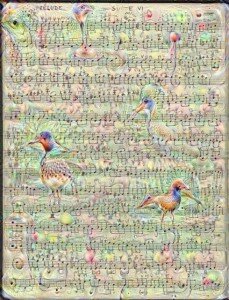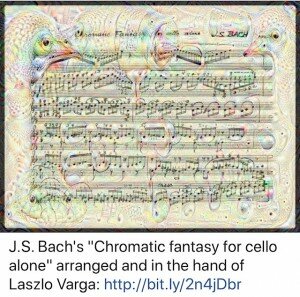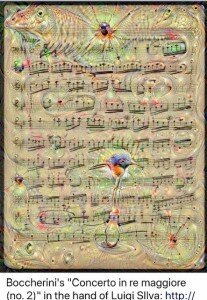When musicians first encounter a piece of music, they begin by learning the notes and rhythm, perfecting the dynamics, and studying the instructions from the composer. These might be sparse and involve merely tempo indications and subtle markings. What then? How do we create forward energy, so that the music feels alive and communicates emotion?
My recent article delves into the creative process. The art of interpretation includes a sometimes long period of searching, of crafting, shaping, or sculpting the composition we’re playing can be enhanced through a number of approaches.
 It’s important to understand that our lines are not alone—we need to try to play not only horizontally, that is, just our own melody, but vertically. The harmony needs to affect the interpretation. Our own part may repeat an identical note —whether it is in a sonata, concerto, or orchestra piece—but if the chordal accompaniment changes, so too should our mood and our portrayal. A change of color or sound quality will give new meaning to the phrase.
It’s important to understand that our lines are not alone—we need to try to play not only horizontally, that is, just our own melody, but vertically. The harmony needs to affect the interpretation. Our own part may repeat an identical note —whether it is in a sonata, concerto, or orchestra piece—but if the chordal accompaniment changes, so too should our mood and our portrayal. A change of color or sound quality will give new meaning to the phrase.
I’ve always used colorful adjectives—anguish, melancholy, sparkling, brooding, wistful, tender, joyful—and musical terms such as dolce (sweetly), legato (connected), flautando (floating or dreamy) to immediately capture my intention for a phrase. Often, I will write these words directly into the parts. Writing in other markings is important too, such as commas, where I want to lift my bow, or pause for a breath in the music, or forward arrows to indicate longer lines, movement, or reaching for the peak of the phrase. All of these tools help me convey the feelings I am seeking to express in the music.
Another essential way to interpret the music is through imagery. Some musicians conjure breezy hilltops, a lover’s quarrel, a raging storm, or fast flowing rivers. This type of mental symbolism in fact, inspired many composers to write the works they did in order to try to imitate life or the natural world in their music.
 Smetana: Ma vlast (My Fatherland) – No. 2. Vltava (Moldau)
Smetana: Ma vlast (My Fatherland) – No. 2. Vltava (Moldau)
The Moldau, a movement from the Symphonic Poem Má Vlast, or My Fatherland by Bedřich Smetana springs to mind. It evokes the flow of the Vltava River through the mountains and the Czech landscape. Richard Strauss’ Alpine Symphony, a tone poem, depicts the struggle to scale the massive mountains in the Alps. Other works attempt to portray war and strife, and fear and foreboding, such as Shostakovich Symphony No. 11, 1905, the War Requiem, by Benjamin Britten, or love tragedies such as Gurre-Lieder by Arnold Schoenberg.
Shostakovich: Symphony No. 11 in G Minor, Op. 103, “The Year 1905” – II. The 9th of January
Schoenberg: Gurre-Lieder
 In order to convey the grandeur or angst the composers intended, our interpretation can be bolstered by reading about the compositions, listening to famous performances of the works, and studying the historical background of the time.
In order to convey the grandeur or angst the composers intended, our interpretation can be bolstered by reading about the compositions, listening to famous performances of the works, and studying the historical background of the time.
Some musicians actually see brilliant hues when they play music. This is called synesthesia and it too can enrich one’s musical interpretation. Google DeepDream takes seeing colors into the 21st century.
This new technology, which is at our disposal, can deepen our vision of the pieces we are working on. Stacy Krim, restores and preserves the music of well-known cellists in her role as the manager of the UNCG Cello Music Collection, a division of the Special Collections and University Archives at the University of Greensboro, North Carolina. The collection includes the music of Luigi Silva, Lev Aronson, Fritz Magg, Gregor Piatigorsky, Bernard Greenhouse, and Elizabeth Cowling, founder of the collection, among many others.
Stacy wondered what the program Google DeepDream would “see” in some of her musical selections. DeepDream originally was created to aid scientists and engineers whose work involved researching images. “Deep dream is a computer vision program created by Google, which uses a convolutional neural network to find and enhance patterns in images via algorithmic pareidolia, thus creating a dream-like hallucinogenic appearance in the deliberately over-processed images.”
 The program has been used to interpret paintings and has become an innovative form of psychedelic and abstract art.
The program has been used to interpret paintings and has become an innovative form of psychedelic and abstract art.
As an experiment, Stacy ran several hand-written sheet music pages through the Google DeepDream program.
Was she surprised! Swirling in front of her eyes, the breathtaking mirages came to life with images of birds, reptiles, fish, and brilliant colors superimposed upon the music. DeepDream is a unique, contemporary way to perhaps inspire young musicians to see beyond the notes on the page and into the core of a composition.
The art of interpretation is complex and each musician must find their own way into the heart of the music they are playing. When we discover how to express and communicate the emotional understanding of the music to the audience, then magic can happen.



